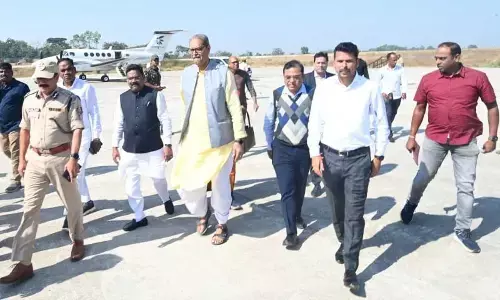Learning from past mistakes: It's time to save urban rivers

Learning from past mistakes: It's time to save urban rivers
It has been observed historically that human settlements often evolved alongside water — near lakes or rivers
It has been observed historically that human settlements often evolved alongside water — near lakes or rivers. The river passing through a city offers ecosystem services that can be seen as a provisioning, regulating and a supporting system. It not only serves as source of water supply, but also helps in balancing flood control and landscape ecology.
Urban riverfronts particularly provide a space for a city to reduce the risks of climate change such as heat island effect and flash floods. They simultaneously provide greater health, space for social cohesion and socio-economic benefits to citizens. Some rivers have always been lent sacredness to the culture in several cities. Socio-cultural and religious elements have always been intricately woven with rivers. A famous saying by prominent urbanist Jane Jacobs goes like: "The waterfront isn't just something unto itself. It's connected to everything else".
And yet, rivers are constantly polluted, moulded, abused and face grave environmental degradation due to urbanisation. Throughout a river's course, anthropogenic activities have adverse impact on the river's watershed. As a result, an urban river becomes a stretch where the function of that water resource is altered from its natural state.
The key issue with river systems in cities is water pollution, point sources such as waste water from a tributary drain, sewage draining and grey water, industrial effluents and wastewater. Other factors include non-point sources such as urban storm water runoff, solid waste and debris, pollution from agricultural fertilisers and chemicals, erosion due to deforestation. The fragmentation of vegetation in the riparian zone due to human settlements and construction are among the other causes. Riparian protection is a critical factor in determining the health of the river as well as that of people dependent on it.
No specific land-use category or legislation — which identifies the 'River Regulation Zone' or 'River Riparian Zone' and the optimum width of this zone — has been identified in India so far.
Moreover, India has various socio-cultural religious issues involved human activities in the rivers like mass idol immersion, cremation by river bank, oily containing offering submerged in rivers etc.
Development inclination at forefront of urban river edges
Accelerated transformation of 'urban riverfront development' has been pushed along the riverbanks in the last few decades. The riverfront development has been reduced to just cosmetic 'river beautification' and unaccountable money spent to increase its real estate and commercial value.
Our rivers are being narrowed far within their actual width with concrete riverbed wall embankments. Since concrete riverbed and channels are the main components of these projects for car parking, plaza, walkways, restaurants etc, the river's flooding capacity and aquatic are adversely impacted. The Sabarmati river channel, for example, has been uniformly narrowed to 275 metres during the riverfront development project, when naturally average width of the channel was 382 metres and the narrowest cross-section was 330 metres.
These projects also often ignore treating the sewage flows into the river through the natural drains and tributaries in the watershed. There are various similar urban riverfront development projects that tell the same story and focus on just the receiving end, compromising on riverbank stabilisation, riparian buffer and immediate floodplain ecological values. Moreover, many such projects are pushed without any kind of social and environment impact assessment and data or facts are dodged for environmental clearance. There's also a lack of regulation or democratic participatory decision.
The way forward
For successful future interventions of blue-green infrastructure solutions, it is necessary to learn from our past mistakes. Recognising what did not work may provide us with directions needed to improve future projects and avoid poorly designed and costly interventions with no social and environmental benefits.
The solutions need to be multi-dimensional, holistic and should involve all relevant stakeholders. The river front development should involve the community to be the key agents for action to mitigate problems related to river pollution. There are many inspiring examples of community-driven river revival efforts in India that show that we need tremendous amount of efforts for a strong public awareness.
For example, youngsters come together to clean Mithi river in Mumbai every weekend. In Tamil Nadu, a local non-profit Clean Conoor, organises clean-up drive for river Conoor.
At the same time, it is essential to understand that the existence of river's ecology is defined by its watershed and not by administrative boundaries. For successful interventions, it is critical to acknowledge the river's flow regime, morphology and scale and align it with characteristics of local urban form.
The uses and functions can be selected in a way that work for a diverse community and provide multiple benefits, including good flood management performance, ecological function, improved aesthetic and health benefits. The main challenge in designing the riverfront development is to improve the quality of the runoff entering into the river while maintaining the infiltration rates in its surroundings. The optimal land-use planning for the riverfront areas by adding green spaces along the river edges is most suitable for balancing the river environment.
The creation of such recreational areas makes riverfront accessible to public to serve more than one purpose. The riverfront is not a hard boundary, but a zone that shifts with time and topography. The riverfronts and river bank floodplains are ecologically very dynamic and meant to be undeveloped for maintaining bank storage, floodplain biodiversity along with natural tributaries and wetlands.
Decision-makers and planners can invest time in carrying out analysis to create potential blue-green spaces around the river. Under no conditions should the riverfronts and riverbanks be concretised where the ecological biodiversity is protected, restored and enhanced — irrespective of any amount of commercial and profit-making values.
Development and conservation need to go hand-in-hand where water and vegetation are seen together to shift from 'hard' to 'soft' engineering approaches. For example, the Yamuna biodiversity park located on Yamuna riverfront was developed by Delhi Development Authority (DDA) with the technical help of Centre for Environmental Management of Degraded Ecosystems (CEMDE), University of Delhi. It serves as an alternative habitat for migratory and resident bird species. It was also designed to conserve wild genetic resources of agricultural crops, enhance groundwater recharge and augment freshwater availability.
Specific legal framework with riparian protection
Riparian zones are as valuable as the river course itself. Hence, regulation and riparian limits should be framed for protection of the actual riverbeds and riparian fringes so that the carrying capacity of the river does not deteriorate and the dynamic biodiversity does not get disturbed. The encroachments inside the river channels and river beds should be checked and riparian fringes be fully protected along with strict and transparent social and environment impact assessments.
Yodogawa river side development in Osaka, Japan, and Room for the Rivers Programme in The Netherlands are the two case examples to refer to for successful models of riverfront development and other interventions at decentralised level.
(Courtesy: DownToEarth)













